If you’ve ever tried to take a relaxing bath only to find that the water won’t drain, you know how frustrating it can be.
A stuck drain stopper can be caused by various factors, including a build-up of hair and debris, a malfunctioning lift and turn mechanism, or even a damaged stopper.
Whatever the cause, it’s essential to address the issue as soon as possible to ensure the smooth functioning of your bathtub.
In this post, we’ll show you step-by-step instructions on removing a stuck bathtub drain stopper and getting your tub back in working order.
Whether you’re a seasoned DIYer or a beginner, our guide will give you the knowledge and tools you need to tackle this common plumbing problem.
About Drain Stoppers
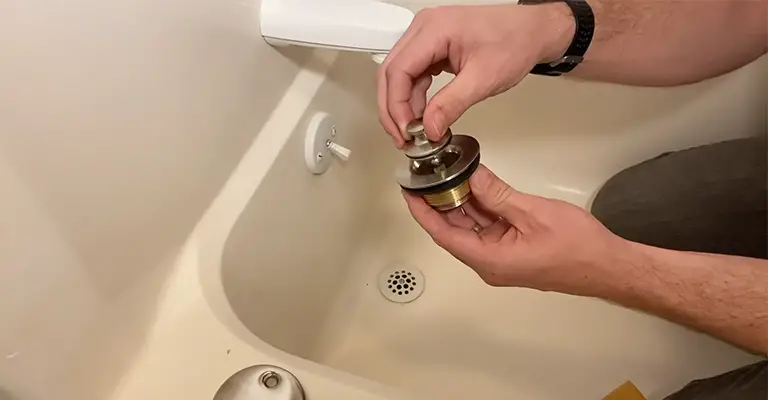
Water, soap, and other common substances are prevented from flowing down the drain when drain stoppers are used in bathtubs and sinks.
Traditional plugs usually tear, warp, and get lost if they’re not tightly fastened to the tub or sink. These innovative devices replace them.
Even though drain stoppers may be better than what they used to be, there are still a few shortcomings that need to be addressed by users.
Most drain stoppers sit inside the drain, so upon installation, they reduce the flow of water through the drain.
Unless the drain stopper gets clogged with dirt, hair, and other debris, this reduction in water flow is rarely noticed.
As a result of drain stoppers’ size, shape, and mechanism, loose debris is more likely to get trapped in them. Therefore, regular drain stopper cleaning is necessary.
Removing the drain stopper may also be necessary for repairing or replacing it. It is impossible to close and open the drain stopper properly if a piece of its mechanism wears out or breaks.
It must be replaced if the drain stopper is broken or the whole stopper is damaged. However, before attempting any repair work, you should first understand how various drain stoppers are installed and removed.
Removing A Stuck Bathtub Drain Stopper
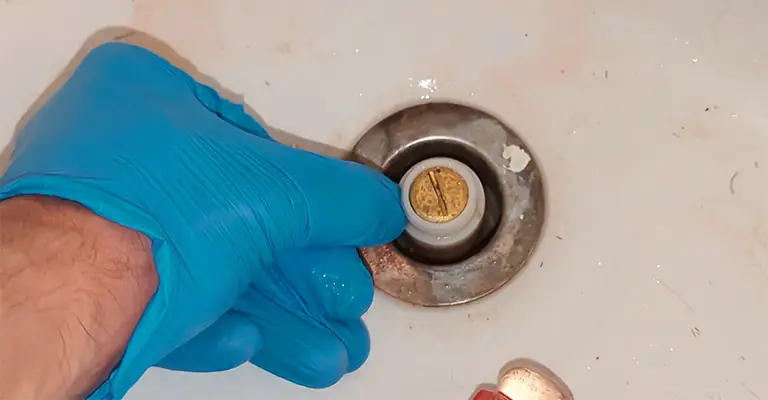
Getting gunk stuck in the drain could lead to the bathtub drain stopper becoming stuck open or closed.
To clean a drain, you must remove the stopper so that the stopper can move freely. Make sure you know which drain stopper you have before removing it.
- Manually moving the stopper is necessary with toe-touch stoppers, push-pull stoppers, and lift-turn stoppers
- Using a lever on the overflow plate, the pop-up stopper opens and closes
- To stop water from draining from the tub, plunger-style stoppers use an internal plunger to cover the drain.
Things You Will Need:
- Pliers
- Old rag
- Penetrating lubricant
- Adjustable wrench
- Old towel
- Drain body remover
- Large flat-head screwdriver
- Small flat-head screwdriver or hex key set
How To Remove Plunger-Style Drain Stopper?
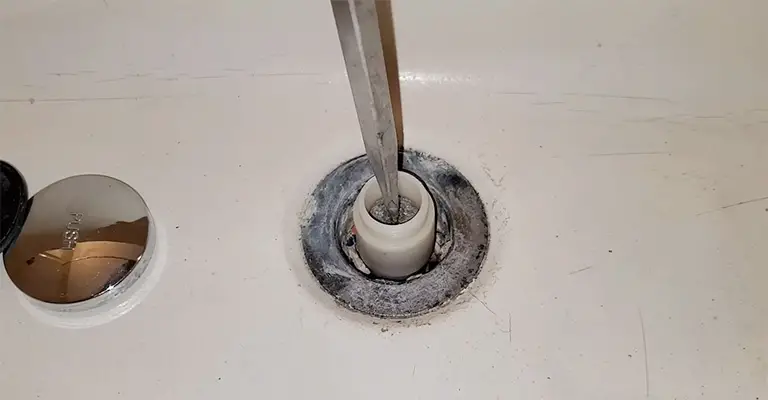
A plunger-style drain stopper is a type of mechanical device that is used to block or allow the flow of water through a drain.
It is typically found in sinks, bathtubs, and showers and is used to prevent water from flowing out of the drain when it is not desired, such as when you are taking a shower or filling a bathtub.
The plunger-style drain stopper consists of a rubber or silicone plunger that is attached to a rod or handle.
To use the plunger-style drain stopper, you simply push down on the rod or handle to lower the plunger into the drain and block the flow of water. To allow the water to drain, you simply pull up on the rod or handle to lift the plunger out of the drain.
Plunger-style drain stoppers are relatively simple and easy to use, and they are a common choice for people who want an inexpensive and reliable way to control the flow of water in their sinks, bathtubs, and showers.
Step 1:
You should cover the strainer with a rag. Doing so, dropped screws are prevented from falling through the strainer’s holes.
Step 2:
You will need to remove one screw from the overflow plate. You’ll need to hold the overflow plate securely while loosening the remaining screw just enough for the faceplate to come away from the overflow pipe.
Replace the first screw in the hole in the bathtub wall with the second screw you removed. By doing this, the overflow pipe will not fall back into the wall. Unscrew the loosened screw.
Step 3:
With your hand, grab the overflow plate. The plunger stopper should be pulled slowly from the drain while the overflow plate is pulled away from the bathtub wall.
Step 4:
You need to pull the rag away from the filter at the bottom of the tub. Disconnect the strainer from the power source by removing the screw. Dispose of the strainer by lifting it from the drain.
Step 5:
The drain body remover, also known as a drain key, must be inserted into the drain body. A counterclockwise key turn can remove the drain body with an adjustable wrench.
How to Remove a Pop-Up Drain Stopper?
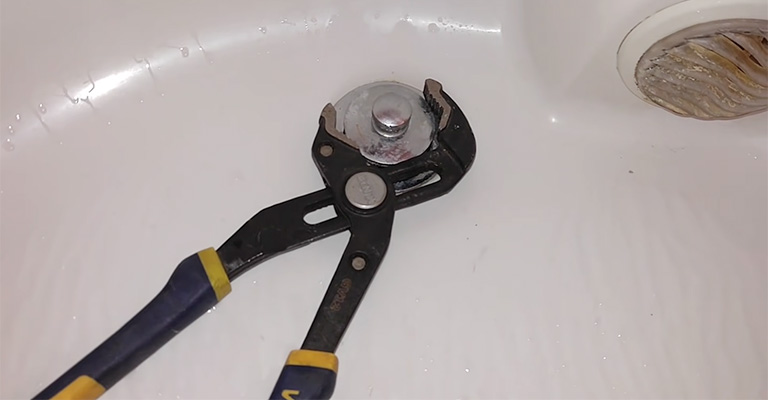
In the same way as trip-lever stoppers, pop-up stoppers have an intricate assembly that fits through the overflow. There is also a lever on the overflow faceplate of these drain stoppers that drops vertically down the overflow drain.
Unlike a plunger, the rod assembly is connected to a spring on top of a rocker’s arm instead of a plunger. In the sink or tub drainpipe, a rocker’s arm regulates the opening and closing of the pop-up plug.
Upon opening the lever, the spring compresses and pushes down on the rocker’s arm, causing the plug to be popped up.
The spring is relaxed in the closed position, allowing the rocker arm to pivot up, closing the drain as the plug is pulled down. A complex assembly of rocker arms and rods makes pop-up drain stoppers prone to clogging.
Step 1:
Pop up the stopper and make sure it’s open. This may require you to lift the lever on the overflow plate or to rotate the plate right or left, depending on your pop-up.
Some faceplates contain a label to let you know which way to turn it so that the stopper is positioned correctly.
Step 2:
Make sure the bottom of your bathtub is lined with an old towel. You can use the towel to protect the bottom of your bathtub and prevent damage from gunk, such as when you remove the stopper from the drain.
Step 3:
Pull the stopper from the drain body by wiggling it back and forth with your hand. To release the stopper, pull it horizontally away from the drain body if a brass arm attaches to the bottom of the stopper.
Step 4:
Use a drain body remover, also known as a drain key, to remove the drain body. You can remove the drain body by turning the key counterclockwise with an adjustable wrench.
How to Remove a Push-and-Pull Drain Stopper?
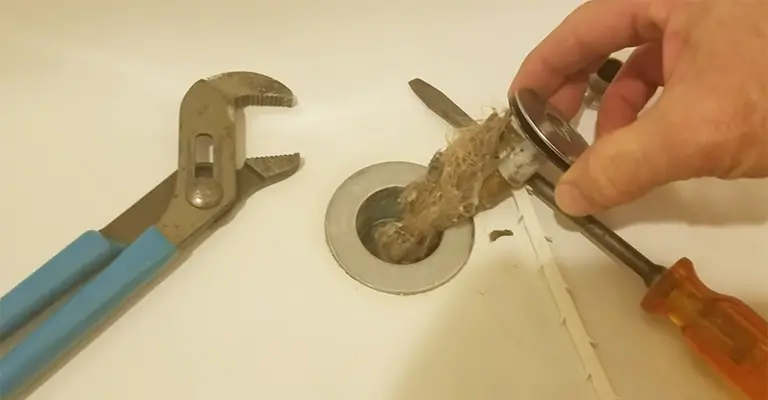
Despite their differing looks and functions, push-and-pull drain stoppers function very similarly to lift-and-turn stoppers.
Even though the knob on a push-and-pull drain stopper is usually wider and smoother than the knob on a lift-and-turn drain stopper.
The mechanism of push-and-pull drain stoppers is very simple, which makes them easy to identify. When you close the drain, just push the plug down, and when you open it, just pull the knob up.
Step 1:
Put an old rag on top of the knob on the bathtub drain stopper. You will be able to see the brass shaft underneath the knob as you remove it by turning it counterclockwise with pliers.
You can loosen a small set screw on the side of the knob with a small flat-head screwdriver or hex key if the knob is not turning.
The threads of the knob may need lubrication if they are difficult to turn. Apply two or three drops of penetrating oil to the threads if this is the case.
Step 2:
Remove the brass shaft by turning it counterclockwise with a large flat-head screwdriver. You will need to remove the stopper to remove the stem.
Step 3:
It may be necessary to slide the screwdriver underneath the stopper to pry it from the drain body. Your fingers should be able to grab the rubber stopper as you pull it from the drain.
Step 4:
The drain body remover, also known as a drain key, must be inserted into the drain body. A counterclockwise turn of the key is used to remove the drain body with an adjustable wrench.
How to Remove a Toe-Touch Drain Stopper?
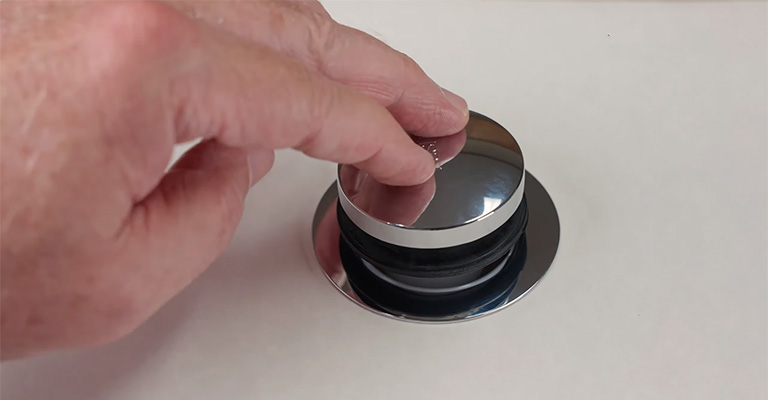
By simply pressing down on the drain stopper, the toe-touch mechanism assembles the drain assembly within the drain and secures it in place.
Upon pushing the drain, it will close, and upon pressing it again, it will open. In most cases, these drain stoppers are circular in shape with a flat lid engraved with the word ‘push’ or completely smooth.
Step 1:
Make sure the bathtub drain stopper is open by pulling up on it with your toes. If you have difficulty pulling up a stuck stopper, use an old rag as a grip.
Step 2:
You can unscrew the stopper from the drain body by turning it counterclockwise. To remove the stem from the drain body, turn the stem counterclockwise with pliers after turning the stopper to remove the drain cap.
If you have trouble removing the cap or stem, apply a penetrating lubricant to the stopper threads.
Step 3:
The drain body can be removed by inserting a drain body remover, also known as a drain key. To remove the drain body, turn the key counterclockwise using an adjustable wrench.
How to Remove a Trip-Lever Drain Stopper?
Unlike flip-it drain stoppers, the trip-lever drain stopper does not feature an easy-to-remove assembly. The overflow faceplate has a lever for operating these drain stoppers.
To operate the plunger, the lever is connected to a rod assembly that drops through the overflow drain vertically. It is possible to raise or lower the plunger by tripping or rotating the lever.
Plungers raise the pressure in the drainpipe, which allows water to flow into the drainpipe, but when they are lowered, they stop the flow of water into the drainpipe.
It can be difficult to remove and replace these drain stoppers because of their complicated assembly.
Step 1:
The drain can be fully opened by flipping or rotating the lever if it is not already in the open position. You could have problems removing the trip-lever drain stopper if you try to do it while it’s closed.
Step 2:
Depending on the type of sink or tub, you may need to remove the overflow grate by loosening the screws and removing the grate. To reinstall the screws, make sure the screws are placed in a safe location.
Step 3:
You’ve got to lift the trip-lever drain stopper assembly out of the overflow drain pipe.
You may want to spray some lubricant on the assembly to free a stuck plunger since the entire assembly, including the trip lever, the rods, and the plunger, needs to be pulled out without breaking anything.
Step 4:
By removing the entire assembly, you can inspect each piece of the assembly after removing it from the overflow pipe for signs of excessive wear and damage, such as rust, cracks, and irregularities.
Whenever possible, replace any pieces showing signs of damage to avoid future issues, such as removing the overflow drain to repair a broken plunger.
How to Remove a Flip-It Drain Stopper?
Using a flip lever, Flip-It drain stoppers expand or contract a gasket in the drain using a flip lever.
During the open position of the flip lever, the gasket contracts, permitting water into the drain, but during the closed position, the gasket is squeezed, expanding to seal the drain.
It is relatively simple to remove these drain stoppers because an O-ring only secures them inside the drain at their base.
Step 1:
The simple style of drain stopper does not require any tools. After opening the drain, turn the lever to release the drain stopper lever. Using a firm twist, pull up and out the entire assembly.
Step 2:
You’ll want to clean out all the hair, soap scum, toothpaste, grime, and anything else you may have accumulated in the drain or on the drain stopper. After that, you’ll want to inspect the stopper for excessive wear and damage.
Step 3:
Check the gaskets and O-rings for wear, misshapenness, or cracks. Ensure the drain stopper is free from cracks, chips, or rust.
It may be necessary to replace the flip-it drain stopper, or if it is still in good condition, you can clean the drain and the stopper with a bathroom cleaning solution, then reinstall them.
Final Words
When a bathtub drain stopper doesn’t work properly, it can be annoying. There is usually a simple fix for the problem, but the steps vary depending on what type of bathtub stopper you have.
In addition to spring-loaded stoppers operated by pushing the toe or hand, some bathtub drains also have trip levers mounted on the overflow plate.







